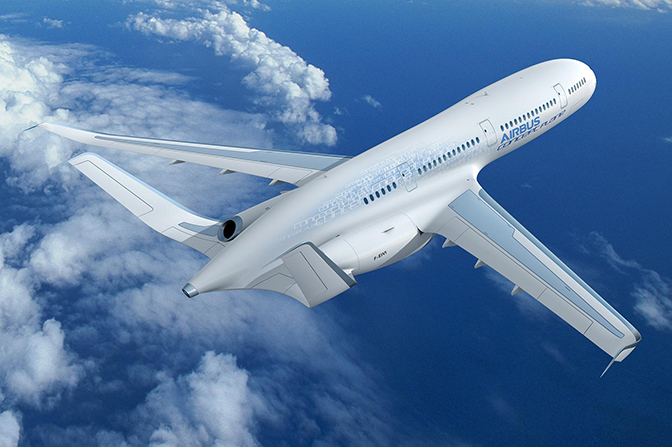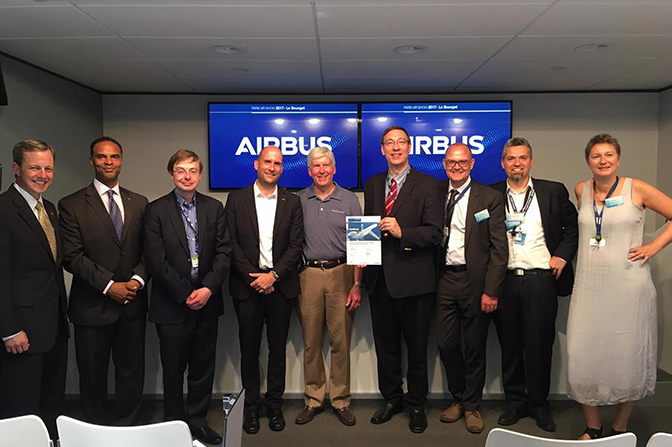
Bend it like Airbus
New $8.25M Airbus center at Michigan for high efficiency aircraft with flexible wings

New $8.25M Airbus center at Michigan for high efficiency aircraft with flexible wings

Long wings could significantly improve the cruise efficiency and reduce the operating cost of long haul aircraft, and Airbus is partnering with the University of Michigan to make these advanced designs possible.
A new joint center will study computer simulation tools and techniques for designing and evaluating future aircraft. The agreement was signed today at the Paris Air Show.
Concepts like elongated wings could reduce fuel burn, emissions and the cost of long-haul flights. But to avoid an increase in weight, those long wings would be more flexible than the conventional designs, which would change the way the plane flies.
The new Airbus-University of Michigan Center for Aero-Servo-Elasticity for Very Flexible Aircraft will develop new computational tools that will help Airbus engineers explore the new design options and reap the benefits of long wingspans while mitigating the new challenges.
“Through our partnership with Airbus, students and faculty members from one of the world’s leading aerospace engineering departments will trade expertise with their counterparts on the cutting edge of the aerospace industry,” said Alec Gallimore, the Robert J. Vlasic Dean of Engineering at U-M. “Together, we can tackle some of the most challenging and complex problems facing advanced aircraft modeling, analysis and design.”
One example of a problem the new center will address is what happens when a more flexible aircraft encounters air turbulence. The team will take a holistic look at the issue with the ultimate goal of maintaining the safety and comfort that passengers expect in conventional aircraft.
“We will be addressing very fundamental research questions while exploring this new uncharted territory in commercial transport aircraft configurations. In this process, we will develop the right computational methods, algorithms and tools,” said Carlos Cesnik, U-M professor of aerospace engineering and the director of the new center. “It is unrealistic to attempt these advanced concepts based on current approaches and experimentally try them.”
We will be addressing very fundamental research questions while exploring this new uncharted territory.
Carlos Cesnik, AERO
Other major questions include how the wings would respond during takeoff, landing and maneuvers. A flexible wing may need new control surfaces to reduce its bend—and these surfaces would likely be engaged automatically so that the pilot could focus on flying the plane.
The center will develop computational models that can address the complexity of the wing’s internal structure, the airflow around it and how to control its behavior. These studies will enable the researchers to discover the forces on the aircraft, how it responds in flight, and how that interplay affects maneuverability and the ride experienced by the passengers. These modeling tools could eventually feed into a flight simulator to help train pilots on the new aircraft designs.

“We’ve designed our innovation organization to motivate our people and ensure we’re open to new ideas and capabilities that exist outside our current team. That openness is a key principle behind everything we do,” said Paul Eremenko, Airbus’ chief technical officer. “University partnerships like today’s help us preserve our tradition of innovation and disruption at Airbus, and serve as examples of our eagerness to work together as we build the future of flight.”
Through the center, Michigan faculty and students will travel to Airbus research centers and Airbus engineers will spend time on campus, working closely together. The new center opens up opportunities not only to trade expertise on new research that addresses the underlying physics of relevant industrial problems—students will also have the chance to intern with Airbus, and Airbus will be able to interact with and recruit top talent in relevant aerospace research fields.
“It is a privilege for Airbus to form strategic partnerships with Georgia Tech and the University of Michigan as this will allow us to embed cutting edge design approaches into our development processes,” said Marc Fischer, Airbus’ senior vice president of flight physics. “Our partners will be a strong support to speed up our development cycles and in consequence shorten our time to market.”
Gallimore is also the Richard F. and Eleanor A. Towner Professor, an Arthur F. Thurnau Professor, and a professor of aerospace engineering.